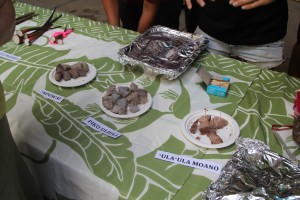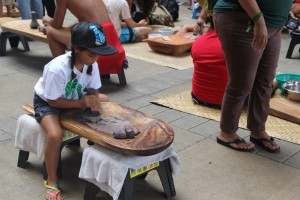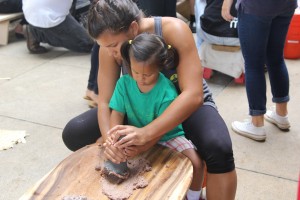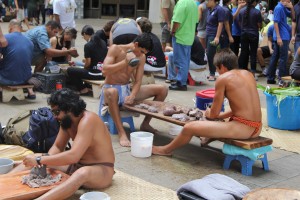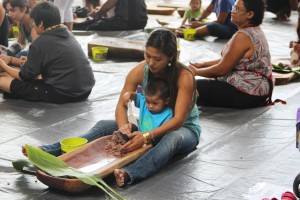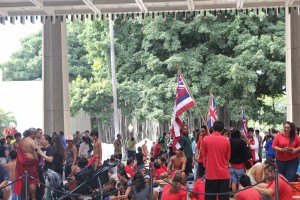Activists lined the streets in front of the capitol building last week as the new 2014 legislative session was set in motion. Where you’d usually find the austere hum of government officials buzzing about their business, a deep rumbling echoed from underneath the rotunda. The thunder from hundreds of rallying citizens pounding away could be heard as far as the palace gates. This was not the marching of angry protesters, however, but the sound of something much sweeter.
Parents, keiki, and many more from the greater community joined together to honor an ancient Hawaiian tradition that is experiencing a much appreciated revival here in Honolulu, the art of making pa’i’ai. Two thousand pounds of steamed taro were provided for the community at large to come and try their hand at making one of this island’s oldest and most revered staple foods. With the allure of freshly pounded poi, often compared to that of freshly baked bread, it was no wonder to find many smiling and jubilant faces, but amidst the crowd, a solemn tone lingered in the air.
Community groups and activists staked the periphery, letting loose a volley of passionate discourse and elevating rhetoric. Charged terms like, “land-acts,” “bio-security,” and “economic viability,” were being flown like paper airplanes across the great courtyard. With Hawai‘i’s precious resources at the focal point, it was no surprise to find community leaders, young and old, ready to lend their hearts and voices to an ancient land who has always provided for its inhabitants unconditionally.
With many small subsistence and community farmers competing with commercial giants for both land and water resources, many humble voices are being drowned out by large corporate megaphones, but organizations such as the Taro Security and Purity Task Force have taken it upon themselves to advocate vehemently on behalf of modest agriculturalists here in Hawai‘i. Acting as an intermediary between the pubic and the state legislation, this organization has spread its roots deeply into the community. Education, representation, and preservation, are a few objectives that this group has been actively pursuing since its inception in 2008.
Amongst the apologists and crusaders, booths also sprang up offering visitors an opportunity to deepen their connection with the land and the issues at hand. Seeds, taro slips, and plant cuttings were available for any gardener to take home and raise as their own, free of charge. The mission of some such organizations was to revive the age-old tradition of seed exchange, or simply put: take a penny leave a penny. This process of passing slips and seeds on to your neighbor not only strengthens community bonds, but increases the diversity of plants being cultivated, and in the case of taro, whose many varieties have been lost to us over the past one-hundred years, it is helping to re-diversify a crop once known for its many assortments and variations.
Needless to say, the image of the taro plant has become a symbol of Hawai‘i’s strength, vitality, and fragility during this renaissance period. A plant whose needs mirror those of its cultivators: fresh water, clean soil, and space to breathe; all of which are becoming harder to find as fields are turned into shopping malls and lo’i into parking lots. This community, kalo in hand, sent a clear and resounding message to the state’s politicians, and though opinions are many, the mashing and pounding of pa’i’ai in the hands of hundreds of citizens is not something to be overlooked.



